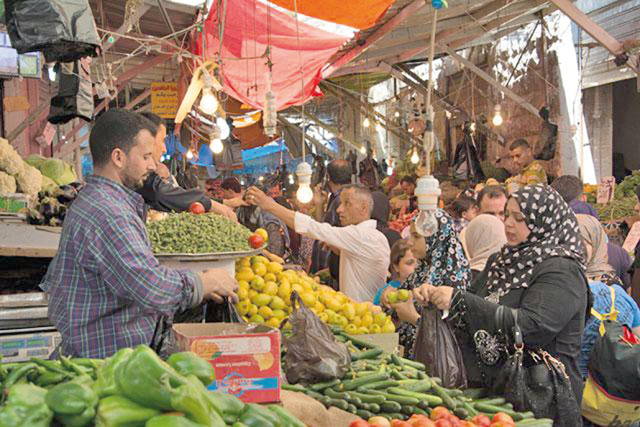You are here
Food prices in Jordan surge by 1.3% in September — report
By Mays Ibrahim Mustafa - Nov 01,2023 - Last updated at Nov 01,2023

Food prices in Jordan increased by 1.3 per cent in September, according to the most recent food security update issued by the World Bank in October (JT file photo)
AMMAN — Food prices in Jordan increased by 1.3 per cent in September, according to the most recent food security update issued by the World Bank (WB) in October.
The monthly report issued by the Department of Statistics (DoS) indicates that the Consumer Price Index (CPI) in September 2023 reached 109.70 compared with 108.41 during the same period in 2022.
Accordingly, the CPI recorded a 1.19 per cent increase compared with September 2022, and a slight increase of 0.52 per cent compared with August 2023, according to the DoS report.
The WB report recorded a gradual increase in food prices in the Kingdom over the past three months, equal to 1.2 per cent in August and 0.6 per cent in July.
It showed that this was preceded by a decrease in food inflation of 0.1 per cent in June and 1.9 per cent in May.
Domestic food price inflation ‘remains high’
The report said that data covering the period from June to September 2023 shows “high inflation” in a large number of low and middle-income countries, with many experiencing double-digit inflation.
It revealed that the most-affected countries are in Africa, North America, Latin America, South Asia, Europe and Central Asia.
Food price inflation higher than 5 per cent was recorded in 57.1 per cent of low-income countries, 83 per cent of lower-middle-income countries, and 59 per cent of upper-middle-income countries, according to the report.
It added that 4.3 per cent of high-income countries are “experiencing high food price inflation”.
The report further showed that real food price inflation exceeded overall inflation in 77 per cent of the 170 countries for which food CPI and overall CPI indices are both available.
It also stated that countries with the highest food price inflation in real terms, based on data available between June and September 2023, include Egypt, followed by Lebanon, Rwanda and Türkiye.
Global trends in agricultural commodity prices
On a year-on-year basis, the prices of maize and wheat have decreased by 28 per cent and 35 per cent, respectively, while rice prices increased by 39 per cent, the WB report revealed.
It also stated that maize prices are currently 6 per cent lower, wheat prices are 12 per cent lower, and rice prices are 19 per cent higher, compared with January 2021.
Speaking with The Jordan Times, Economist Hosam Ayesh highlighted various global variables which might have driven the increase in food prices in Jordan and around the world.
These include halting the grain deal between Russia and Ukraine, and the growing risks associated with climate change which had an “adverse” impact on the harvest of some of the top producing-countries of agricultural commodities.
He also noted that the global rise in energy prices which are “already high” in Jordan, mainly due to taxes, have impacted production costs and contributed to food inflation.
Moreover, some countries such as India and Thailand have either banned rice exports or imposed additional taxes on them, which caused their prices to bounce around the world, he added.
War on Gaza to exacerbate food inflation in region
If the Israeli war on Gaza drags or spills into other neighboring countries, there will “definitely” be serious repercussions on food prices in the region, according to Ayesh.
He said that this kind of war will have an adverse impact on supply chains. It can also push energy prices up, increase demand on food commodities, raise storage costs, and impact access to “strategic” goods and foodstuff.
Related Articles
AMMAN — The food security update issued by the World Bank (WB) on September 14 showed that food prices in Jordan only increased by 0.6 per c
AMMAN — The prices of 84 commodities rose in September compared with their prices at the beginning of this year, according to a study
PARIS — World food prices fell in 2023, with considerable declines for grains and oils as supply concerns eased, the UN's Food and Agricultu

















